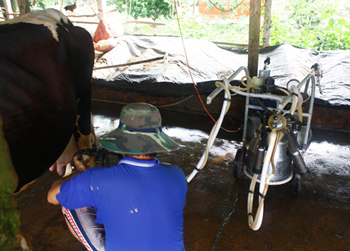 Story and Photos by Nguyen Xuan Quyen | Communication and Networking Officer | Heifer Vietnam
Story and Photos by Nguyen Xuan Quyen | Communication and Networking Officer | Heifer Vietnam
Started in early 2004, the Heifer International project in the Long Tuyen Commune supported 10 original farmers with two dairy cows each. Over the first three years, the project, called Promote Dairy Cows Raising in Farmers Households in Long Tuyen Commune, Can Tho City, enabled participating farmers to sustain their livelihood by raising dairy cows and establishing a revolving fund. There are now 220 dairy cows, 10 original members and 10 members who received cows through Passing on the Gift®.
The number of dairy cows each member has ranges from several to twenty-something, and the daily amount of milk collected varies as well. Farmers sell the milk to the Can Tho Dairy Factory, about three miles from the community. With even a little amount of milk, small farmers find it very hard to sell their product to the milk processor company, and the individual farmers may not receive the best prices when working on their own. In addition, feed for the dairy cows can be expensive.
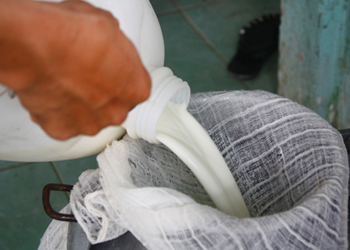 To combat these obstacles, the 20 members came together to pool resources, minimize labor costs and food expenditures, and maximize benefits they generate for themselves. Since its formation in 2007, the dairy cow cooperative has manifested its role in improving livelihoods in the community.
To combat these obstacles, the 20 members came together to pool resources, minimize labor costs and food expenditures, and maximize benefits they generate for themselves. Since its formation in 2007, the dairy cow cooperative has manifested its role in improving livelihoods in the community.
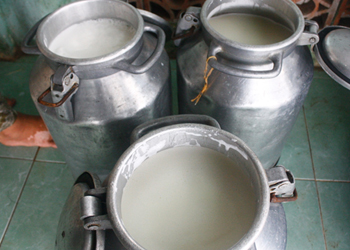 The dairy cow co-op of 20 members is big enough for them to care for and support each other, and more members have opportunities to enhance their roles in the association. The co-op is run by the board of cooperative management, which has five members. The board manages the cooperative, pools resources and maintains the cooperative fund. Vo Thanh Can, the co-op leader, manages general activities while the co-op cashier records the fund. Le Viet Bac, a co-op member, is in charge of pooling resources for the entire co-op, such as by-products and dairy cow feed, and searches for the markets for cow milk output. Every two weeks, he purchases commercial feed at the cattle-feed dealer and brewer’s grains from the beer factory. By purchasing a large quantity of food, the co-op can get a good price.
The dairy cow co-op of 20 members is big enough for them to care for and support each other, and more members have opportunities to enhance their roles in the association. The co-op is run by the board of cooperative management, which has five members. The board manages the cooperative, pools resources and maintains the cooperative fund. Vo Thanh Can, the co-op leader, manages general activities while the co-op cashier records the fund. Le Viet Bac, a co-op member, is in charge of pooling resources for the entire co-op, such as by-products and dairy cow feed, and searches for the markets for cow milk output. Every two weeks, he purchases commercial feed at the cattle-feed dealer and brewer’s grains from the beer factory. By purchasing a large quantity of food, the co-op can get a good price.
The co-op’s fund, composed of an $800 grant award from the 2007 Golden Talent Award and each original member’s contribution of $125, was mainly used to buy commercial feed, brewer’s grains and pineapple peels. At the end of every year, members deduct operating expenses and split the profit among themselves. They continue using the dividends to buy commercial feed and by-products for the cows.
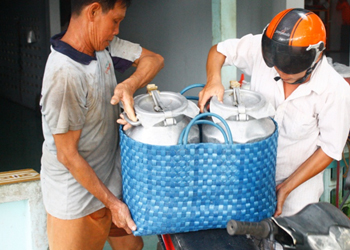 Relationships grow stronger as the co-op proves its benefits. The pass-on members now have several cows that produce milk daily and have a milk-supply contract with Can Tho Dairy Factory. Twice a day, after milking, they gather the milk and carry the containers to the factory.
Relationships grow stronger as the co-op proves its benefits. The pass-on members now have several cows that produce milk daily and have a milk-supply contract with Can Tho Dairy Factory. Twice a day, after milking, they gather the milk and carry the containers to the factory.
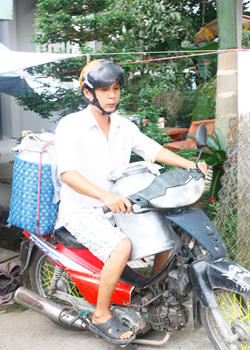 The project has helped the farmers make a sustainable livelihood, and they have become self-reliant. Most participating farmers primarily rely on dairy cows.
The project has helped the farmers make a sustainable livelihood, and they have become self-reliant. Most participating farmers primarily rely on dairy cows.
Can said, “I am busy feeding, bathing and milking more than 20 dairy cows a day and the milk brings a high and stable income?$1,300 a month?to my family. This is the main occupation of our family and other members.”
Hoang, a co-op member, added, “I have 10 dairy cows, and every morning and afternoon, after milking, I bring the milk to Mr. Can. My family’s income from the dairy cow is approximately $300 to $350. It is our main occupation.”
The dairy cow project also helps form a healthy habit of drinking milk in the community. Every day, at a scheduled time, people come to buy milk for their children and become friendly customers of the co-op.
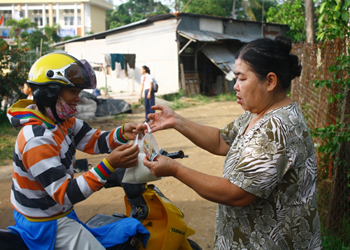 | 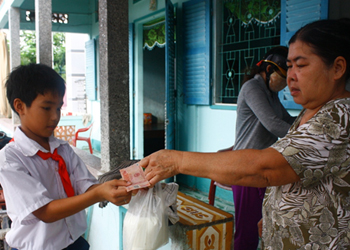 |
| After school, students, teachers and local people come to buy milk for home consumption. Some drink milk and some make yoghurt from milk. | |